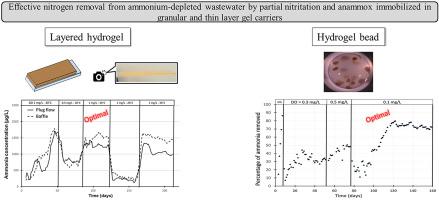Water Research ( IF 11.4 ) Pub Date : 2020-06-20 , DOI: 10.1016/j.watres.2020.116078 Matthieu Landreau 1 , Samuel J Byson 1 , HeeJun You 1 , David A Stahl 1 , Mari K H Winkler 1

|
This study investigates the effect of physicochemical conditions on the partial nitritation and anammox treatment by immobilized ammonia oxidizers under ammonium-deplete conditions. The impact of oxygen and temperature was studied by measuring the activity of immobilized aerobic and anaerobic ammonia-oxidizing organisms (Ammonia-oxidizing bacteria (AOB) and archaea (AOA), and Anammox bacteria) embedded in polyvinyl alcohol – sodium alginate (PVA-SA) beads and in thin layer poly-ethylene glycol hydrogels. Beads and flat hydrogels were incubated in a fluidized bed reactor (FBR) and in two flow cells, respectively. Both systems were fed with synthetic wastewater (15 mg N–NH4+/L) at different temperatures (20 °C and/or 30 °C) and different dissolved oxygen (DO) concentrations (0.1, 0.3, 0.5 and/or 1 mg/L) over 152 and 207 days, respectively. The FBR system had a maximum removal rate of 1.7 g-N/m3/d at 0.1 mg O2/L, corresponding to 80% removal efficiency, while a high aerobic ammonia-oxidizing activity but a partial oxygen inhibition of Anammox bacteria were observed at higher DO concentrations. In both flow cells, nitrogen removal efficiency was highest (80%) at 30 °C and 1 mg O2/L while removal was less favorable at lower DO and lower temperature. Our results indicate a potential use of hydrogel beads for an energy efficient technology with reduced aeration demand for treating low ammonia wastewater, while layered hydrogels are a possible first step for biological treatments of wastewater using tangential flow. In addition, we provide blueprint drawings of the flow cells, which may be used to 3D-print the apparatus for other applications.
中文翻译:

通过部分硝化和厌氧氨氧化固定在颗粒状和薄层凝胶载体中,可有效去除贫铵废水中的氮。
本研究探讨了在铵缺乏条件下,固定化氨氧化剂对部分亚硝化和厌氧氨氧化处理的理化条件的影响。通过测量固定在聚乙烯醇-海藻酸钠(PVA-SA)中的固定的需氧和厌氧氨氧化生物(氨氧化细菌(AOB)和古细菌(AOA)以及厌氧氨氧化细菌)的活性,研究了氧气和温度的影响。 )珠和薄层聚乙二醇水凝胶。珠子和扁平水凝胶分别在流化床反应器(FBR)和两个流通池中孵育。两种系统都注入了合成废水(15 mg N–NH 4 +/ L)分别在152天和207天中在不同温度(20°C和/或30°C)和不同溶解氧(DO)浓度(0.1、0.3、0.5和/或1 mg / L)下进行。FBR系统在0.1 mg O 2 / L时的最大去除速率为1.7 gN / m 3 / d ,对应于80%的去除效率,而高温厌氧菌具有较高的需氧氨氧化活性和部分氧气抑制作用。溶解氧浓度更高。在两个流通池中,在30°C和1 mg O 2时,脱氮效率最高(80%)。/ L,而在较低的DO和较低的温度下去除效果较差。我们的结果表明,水凝胶微珠可能用于减少能耗的低能耗废水处理的节能技术,而层状水凝胶则是切向流生物处理废水的第一步。此外,我们提供了流通池的蓝图,可用于对设备进行3D打印以用于其他应用。











































 京公网安备 11010802027423号
京公网安备 11010802027423号